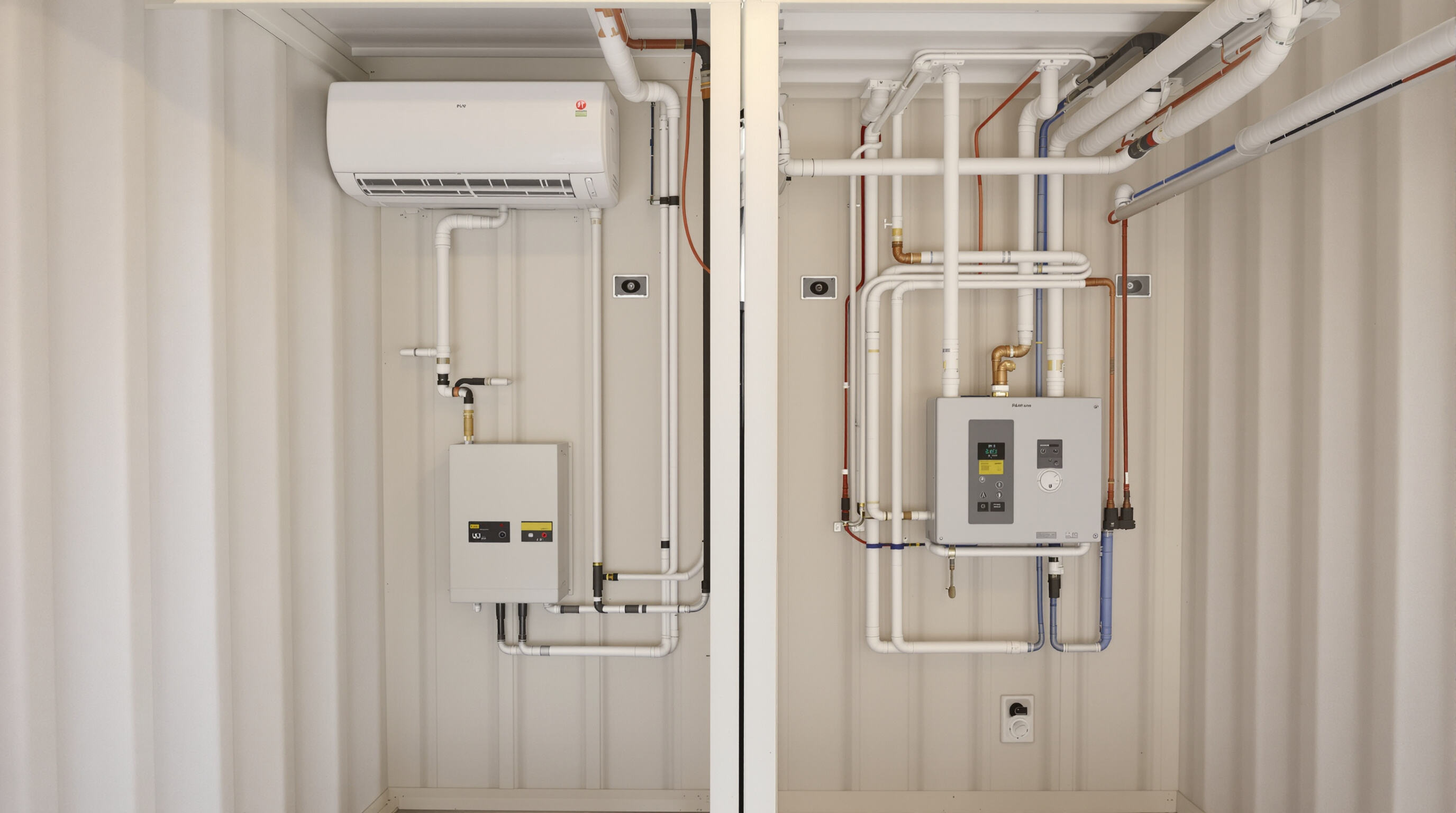Understanding Container House Connectivity and Its Growing Appeal
What Defines a Container House in Modern Modular Construction
Container houses today are basically steel buildings built from old shipping containers that follow ISO standards, usually around 20 feet or 40 feet long. The way they're designed lets them stack neatly on top of each other and lock together, so building goes much quicker compared to regular wooden houses. We're talking about a time savings of somewhere between 30 to maybe even 50 percent. When these containers reach the construction site, they already come sealed against weather with doors and windows already cut out, which cuts down on labor expenses quite a bit. Some recent numbers from modular construction in 2024 suggest savings could be as high as eighteen dollars per square foot. There are plenty of reasons why people choose this approach over traditional methods.
- A structural lifespan of up to 55 years—more than double that of conventional wood-frame homes
- Steel content that is 90% recyclable, aligning with circular economy principles
- Standardized dimensions (8' width, 9.5' height) that simplify connectivity and layout planning
Why Connecting Multiple Container Houses Is Gaining Popularity
The global connected container home market is projected to reach $73 million by 2025, driven by a 214% increase in multi-unit configurations since 2020. This growth is fueled by three key factors:
- Affordability - Linking containers costs 20–40% less per square foot than conventional home additions (2024 Modular Construction Report).
- Flexibility - With the rise of remote work, 68% of buyers now seek hybrid office-residential layouts, which multi-container designs easily accommodate.
- Sustainability - Connected units reduce land use by 22% compared to standalone homes while reusing over 8,000 lbs of recycled steel per container.
About 37 percent of all new construction these days comes from urban infill projects. Cities including Los Angeles have made it easier to get permits for multi-container accessory dwelling units (ADUs), helping tackle the serious housing crisis we're facing. Some pretty cool innovations are making waves too. Take those slide and lock connectors for instance. They let builders add or remove modular sections within just three to five days, which beats out regular renovation timelines by miles. This supports what's becoming known as the rightsizing movement in housing. Looking at recent research from 2024, smart container homes that share things like heating systems and solar panels actually save around 31% more energy compared to standard setups. Makes sense when you think about how sharing resources cuts down on waste and costs.
Structural Connection Methods for Safe and Stable Container House Joints
Welding vs. Bolted Connections for Container House Joints
Welding creates those solid, unbreakable joints that work really well when building multi story container homes. A recent study from the Modular Building Institute found that these welded joints can handle about 25 percent more wind force compared to regular bolted systems. But here's the thing about bolts they give builders way more flexibility, which is why many people choose them for temporary setups or buildings that might need expanding later on. When going for something that lasts forever though, adding steel plates to reinforce those welds makes all the difference, especially in places where winds regularly hit speeds over 110 miles per hour. Most experienced contractors will tell you this is standard practice for any two story container home construction project worth its salt.
Using Steel Beams and Moment Frames for Structural Stability
The importance of moment resisting frames cannot be overstated when it comes to spreading out those sideways forces across multiple connected containers. According to Engineering News Record from last year, these failures account for around 85% of problems in multi container setups. When we install those W12x26 steel beams between individual units, something interesting happens. The whole system starts working together better, creating these continuous pathways for loads to travel through. This actually cuts down on twisting stress by about 40% compared to just having standalone containers sitting next to each other. Looking at what researchers found with curtain walls tells us why this matters so much. Those rigid connections need to handle every single bending moment if we want to prevent joints from warping over time. Otherwise, stability becomes a real concern down the road.
Foundation Alignment and Load Distribution Challenges
| Consideration | Single Container | Connected Containers |
|---|---|---|
| Max Differential Settlement | 1" | 0.25" |
| Minimum Footing Depth | 18" | 24"+ |
| Soil Bearing Capacity Needed | 2,500 psf | 3,800 psf |
Uneven settling causes 62% of structural issues in connected setups (ASCE 2022). To maintain alignment, laser-guided leveling and reinforced grade beams are used to keep angular deviation below 0.1° across foundation pads.
Case Study: Multi-Container Home in Austin with Rigid Frame Connections
A four-container residence in Austin featuring X-braced moment frames endured 2023’s record 94 mph windstorms without any joint failures. Post-event inspections revealed only 0.08mm crack widths at weld points well under the 1.5mm threshold for structural concern.
Design Strategies for Seamless Aesthetic and Functional Integration
Open-Plan Layouts and Interior Flow Between Connected Units
Removing internal walls between container modules creates open, light-filled spaces that enhance livability. A 2022 National Association of Home Builders study found that 68% of modular homeowners prioritize unbroken sightlines between kitchen, dining, and living areas. Sliding glass doors or retractable partitions preserve spatial flexibility while ensuring ADA-compliant 36” clearances between units.
Roof and Cladding Continuity for Visual Uniformity
Using consistent roofing materials—such as standing-seam metal or solar-integrated panels—across all containers ensures visual cohesion. For vertical cladding, professionals employ laser-guided installation to align seams within 1/8”, minimizing gaps that can accelerate corrosion in coastal environments.
Addressing Thermal Bridging and Insulation Gaps at Connection Points
Joints between containers contribute to 23% of total heat loss in connected homes (2023 energy modeling data). Best practices involve combining spray foam insulation with non-conductive thermal break spacers made from recycled polypropylene, achieving R-15 performance at connections. Vapor barriers should extend at least 6” beyond joints to prevent moisture accumulation.
Trend Analysis: Prefabricated Connector Modules for Container Homes
Pre-engineered connector modules now streamline multi-container builds by integrating utility routing and structural transitions. These galvanized steel units reduce on-site assembly time by 40% compared to field-welded methods and feature plug-and-play electrical and plumbing interfaces compliant with IRC standards for residential clusters.
Integrating Utility Systems Across Connected Container Houses

Plumbing and HVAC Routing Between Container Units
Getting utilities properly coordinated makes all the difference when it comes to how well things work long term. When installing main water lines, running them inside shared wall spaces or underneath raised floor areas works best. Flexible PEX tubing handles temperature changes better than copper pipes, standing up to freezing conditions about 60% longer. That's why many installers prefer it for this kind of work. Speaking of climate control, most container builds these days go with ductless mini split systems instead of traditional ductwork. The ASHRAE data shows they save around 35% on energy costs compared to regular HVAC setups. Don't forget about airflow between containers either. Adding proper ventilation along with moisture resistant materials stops those annoying condensation problems where different sections connect.
Electrical Circuit Distribution and Safety Compliance
Centralized electrical panels equipped with arc-fault circuit interrupters (AFCIs) are now required in 92% of U.S. jurisdictions for container home clusters (NEC 2023 update). Essential considerations include:
- Dedicated 20-amp circuits for kitchenettes in each unit
- GFCI-protected outdoor circuits along inter-unit pathways
- Load-balancing for 400V three-phase systems in larger installations
A 2024 UL Solutions study showed properly grounded container homes experience 78% fewer electrical faults than conventional stick-built houses.
Data and Smart Home Infrastructure in Multi-Container Setups
Modern clusters increasingly rely on structured cabling with CAT7a Ethernet (supporting 100 Gbps throughput) for robust wired/wireless networks. Integrated systems include:
- PoE++ lighting controls (90W per port)
- Distributed Wi-Fi 6E mesh nodes (QAM-1024 modulation)
- Fiber optic backbone links between containers
This infrastructure supports centralized building management systems that optimize HVAC and lighting based on occupancy data from 360° LiDAR sensors, delivering 42% energy savings in multi-container deployments (IEEE 2023 smart home report).
Navigating Building Regulations and Environmental Resilience
Building Codes and Permits for Multi-Container Residential Projects
The rules around container homes really affect how connected these structures can be. About 72 percent of places across the United States need special permits when multiple units are involved according to World Green Building Council data from last year. Getting everything right depends on things like floor space calculations, making sure there's proper fire separation between different living areas, and keeping ceilings at consistent heights throughout. Take San Francisco as a case study their new modular housing rules from 2023 demand those seismic bolts at connection points plus full engineering approval before stacking containers on top of each other. The latest building standards also focus heavily on reducing heat loss through structural connections, so they're asking for insulation gaps no bigger than half a millimeter at all joining spots. This level of detail makes construction planning much more complex for developers working with repurposed shipping containers.
Wind, Seismic, and Weather Resistance in Connected Container Designs
The connected units need to pass pretty tough tests these days. They've got to withstand wind speeds of around 130 mph in areas prone to hurricanes, plus handle seismic forces reaching 0.4g in earthquake risk zones. When it comes to framing, builders are increasingly turning to rigid connections made from ASTM A572 steel beams. These actually cut down on sideways movement by about 40% when compared with traditional bolted methods. For properties located where flooding is common, there's also special elevation systems that lift the structures anywhere from 12 to 36 inches above what FEMA considers baseline flood levels. Looking at what's happening in Florida's coastal markets, developers now routinely incorporate features like sloped roofs designed to channel water away and apply those tough impact resistant films on windows across their container-based projects.
Sustainability and Energy Efficiency in Expanded Container Homes
When buildings are connected together, they tend to score around 15-20% better on ENERGY STAR ratings because of shared solar panels and zoned heating/cooling systems throughout the complex. The Environmental Protection Agency has recently updated its requirements too, insisting on sealants that don't release harmful chemicals at connection points, plus at least two thirds recycled steel when expanding modular structures. Take Phoenix for instance where one building actually reduced cooling needs by nearly a third after positioning three shipping containers to catch the wind direction and filling gaps between them with spray foam insulation. For places with mild weather patterns, creating open spaces between adjacent units works wonders too. These simple air channels slash reliance on mechanical heating systems by roughly 15-20% during colder months.
FAQ
What are container houses made from?
Container houses are built from repurposed shipping containers, typically made of durable steel and adhering to ISO standards for size and strength.
Why are container houses popular?
Container houses are popular due to their affordability, quick construction time, and environmental sustainability. They offer a structural lifespan significantly longer than traditional housing options.
How are multiple container houses connected?
Multiple container houses can be connected using welding or bolted connections, steel beams, and moment frames to ensure stability and distribute forces effectively.
What is the significance of using beams and frames in container homes?
Using steel beams and moment frames in container homes helps stabilize the structure by evenly distributing loads and reducing stress, especially critical in areas with high wind or seismic activity.
Are special permits required for building container homes?
Yes, many regions require special permits for multi-container constructions, often needing compliance with specific building codes related to safety, fire separation, and environmental considerations.
Table of Contents
- Understanding Container House Connectivity and Its Growing Appeal
- Structural Connection Methods for Safe and Stable Container House Joints
- Design Strategies for Seamless Aesthetic and Functional Integration
- Integrating Utility Systems Across Connected Container Houses
- Navigating Building Regulations and Environmental Resilience
- FAQ


